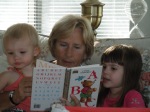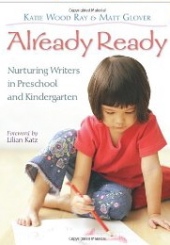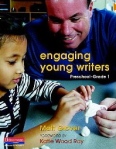 I’ve had several questions asked of me lately from preschool parents and teachers. They all want to know what they should be doing when their children are 3, 4, and 5 so that the kids will eventually have a successful “learning to read” experience. For the parents, I want them to know 3 important things.
I’ve had several questions asked of me lately from preschool parents and teachers. They all want to know what they should be doing when their children are 3, 4, and 5 so that the kids will eventually have a successful “learning to read” experience. For the parents, I want them to know 3 important things.
1. Reading aloud to your children is the single most important thing you can do with your children. Finding fun books both in fiction and non-fiction is the best way to turn your kids on to reading. Use your libraries. Buy books as part of birthday and holiday presents. By reading to them with expression you send messages to your kids. The little ones will be thinking, “WOW, I want to be able to do that some day!”
2. Forcing children to learn their letters and sounds at age 3 and 4 will not necessarily guarantee that the children will maintain a two-year advantage on other students who only learn their letters and sounds in kindergarten. Many children can catch up to these early readers. By the end of first grade many late starters catch up and level off with the early starters. However, if children do show an interest in letters and sounds at age 3 and 4, then certainly play with the letters and have fun. Sing the ABC song in the car, do puzzles, play with the sponge letters in the tub, make the magnetic letters accessible on the refrigerator, and throw out some “hooks” for the letters during your play. For example, “D, that’s Daddy’s letter and Dawson’s letter!” “N is for Nana and O is Owen’s special letter.” “R is for Robot. Let’s pretend we are robots.”
3. Talk to your children. Have conversations. Pay attention to their interests. Expand on what they are saying. Language development and vocabulary building can be done in the context of real conversations. I am always saddened when I see a parent pick up his/her child at preschool with a phone attached to the ear or texting someone as they gather the child’s coat and drawings. Listen to your children. Retell favorite stories together. Make up and act out stories together.
To the preschool teachers of 4-5 year olds or kindergarten teachers of children who are struggling with learning letters/sounds, I’d recommend these readings:
- In Catching Readers Before They Fall, we talk about kindergarteners that are struggling with learning to identify their letters. Read page 115-121 to see how we help kids learn about the “features of print.” Some kids need to learn to notice the shapes of the letters BEFORE you ever start giving each letter a name.
- Remember that learning left-to-right orientation and voice-print matching is just as important an early skill as learning letters and sounds. Hopefully preschool and kinder teachers are doing lots of Shared Reading with Big Books and Poems on charts. Also in One Child at a Time on pages 107-114, you can read about making little books with the kids. Appendix B in One Child and Appendix 9 in Catching Readers give some samples. This is definitely one way to make the learning fun.
- Making a personal ABC book for the child who is having trouble learning his letters is crucial. Only put in the letters that the child knows with a picture of his “hook” for that letter (the picture can be a sticker or a simple drawing). His personal “hook” may be different from the ABC chart you use in your classroom. That’s OK. If the child is wild about robots and dinosaurs, then those are better hooks for him than a “ring” or a “door”. If he knows his brother’s name is Josh then that can be his hook for J. Leave spaces for the letters he doesn’t have a hook for or can’t ID that letter. When you read his personal ABC book with him, you will just say those letters on those pages (even though there is nothing there), and he will point and read the ones he knows. You only add the letter and the hook as he learns it. In Catching Readers, Chapter 11, we answer a question for parents about “what if my child has trouble learning his letters?” Look for that on pages 202-204.
- Use SMALL GROUPS for those 3-5 kids who aren’t strong in letter ID and sounds. Do small group Shared Reading and small group Interactive Writing. These are the kids who will normally NOT be fully attending when you are doing Interactive Writing/Shared Reading with the whole group. You need ACTIVE ENGAGEMENT from them — and the only way to be sure you are getting that is if they are right there with you; maybe even 2-3 at a time.
- Games sometimes help. I used to make “hopping boards” on poster boards. I would just draw a hopping board and put stickers on it. One with all dinosaur stickers would be called the Dino Game. Then I’d make another one with “Hello Kitty” or some other popular cartoon character on it. The kids would think they were different games, and yet I used them for letter practice (or sight word practice with older kids.) I was always amazed that kids would choose these homemade board games over packaged games. Anything to take away the idea of skill-and-drill and to make it fun. But remember, games cannot replace the time for real reading or writing. These would be things they would chose in their free play time.
“Games in general have little value, but designed specifically for a particular child and used for a brief period of time they may help to increase the items that a child remembers.” Literacy Lessons 2, Clay, p. 176
6. Give kids time to write every day. These may only be drawings or scribbles, but that’s OK. Read one of the books by Matt Glover or Katie Wood Ray on writing with preschoolers (see pictures below) or discover the wonderful work that Giacobbe and Horn have done in kinder classrooms.
7. Reread favorite stories and act them out. Provide props or stick puppets to retell stories.
Hope some of these ideas help. Any comments or other thoughts are welcome.




Thanks for this great post, Pat! When I read the line that said you had three important things to say to parents, I tried to predict what they would be. I came up with read to your kids, talk to your kids, and write with your kids. Glad to know we are of like minds!
Excellent information! I agree with all of the points you raised and I implement all of it in our daily activities. I too, get so upset when I watch parents who sometimes aren’t even on their phones yet still do not communicate with their preschooler when they pick them up from school. Silence from the preschool doors to the car. Disheartening. What a loss of valuable bonding, discovering and learning time…. Thanks for a great read!
I fell into the trap of thinking that by getting my son to read or go through his letters would encourage him to want to read freely, I soon discovered that it had the opposite effect. I backed off a little and let him choose his own reading material, 2 years later he is free reading at will and getting great pleasure out of it.
Kids develop at their own pace and IMO a one size doesn’t fit all!
Thank you for some goods tips/advice.
Sue
Pingback: Parents Want to Know | Catching Readers Before They Fall
Great list! I’d add selective use of the Leap Frog Letter Factory video. Most of the Leap Frog videos aren’t very good, but Letter Factory and Talking Words Factory are excellent. My children had very limited TV exposure when they were little, so when they got to watch the letter video it was a really big deal and they paid attention.
We also used to make sound boxes out of old tissue boxes, and put things inside that started with the letter T, P, etc.